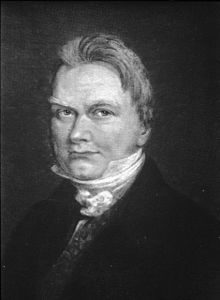Jöns Jacob Berzelius
Appearance

Jöns Jacob Berzelius (20 August 1779 – 7 August 1848) was a Swedish chemist, considered along with Robert Boyle, John Dalton, and Antoine Lavoisier, to be one of the founders of modern chemistry.
| This scientist article is a stub. You can help out with Wikiquote by expanding it! |
Quotes
[edit]- Every chemical combination is wholly and solely dependent on two opposing forces, positive and negative electricity, and every chemical compound must be composed of two parts combined by the agency of their electrochemical reaction, since there is no third force. Hence it follows that every compound body, whatever the number of its constituents, can be divided into two parts, one of which is positively and the other negatively electrical.
- Jöns Jacob Berzelius Essai sur la théorie des proportions chemiques (1819), 98. Quoted by Henry M. Leicester in article on Bessel in Charles Coulston Gillespie (editor), Dictionary of Scientific Biography (1981), Vol. 2, 94.
- A tidy laboratory means a lazy chemist.
- Jöns Jacob Berzelius to Nils Sefstrom, 8th July 1812. In C. G. Bernard, Berzelius as a European Traveller, in E. M. Melhardo and T. Frängsmyr (eds.), Enlightenment Science in the Romantic Era (1992), 225.
- As mineralogy constitutes a part of chemistry, it is clear that this arrangement [of minerals] must derive its principles from chemistry. The most perfect mode of arrangement would certainly be to allow bodies to follow each other according to the order of their electro-chemical properties, from the most electro-negative, oxygen, to the most electro-positive, potassium; and to place every compound body according to its most electro-positive ingredient.
- Jöns Jacob Berzelius, An Attempt to Establish a Pure Scientific System of Mineralogy (1814), trans. J. Black, 48.
- Chemical signs ought to be letters, for the greater facility of writing, and not to disfigure a printed book ... I shall take therefore for the chemical sign, the initial letter of the Latin name of each elementary substance: but as several have the same initial letter, I shall distinguish them in the following manner:— 1. In the class which I s hall call metalloids, I shall employ the initial letter only, even when this letter is common to the metalloid and to some metal. 2. In the class of metals, I shall distinguish those that have the same initials with another metal, or a metalloid, by writing the first two letters of the word. 3. If the first two letters be common to two metals, I shall, in that case, add to the initial letter the first consonant which they have not in common: for example, S = sulphur, Si = silicium, St = stibium (antimony), Sn = stannum (tin), C = carbonicum, Co = colbaltum (colbalt), Cu = cuprum (copper), O = oxygen, Os = osmium, &c.
- Jöns Jacob Berzelius, Essay on the Cause of Chemical Proportions, and on some circumstances relating to them: together with a short and easy method of expressing them', Annals of Philosophy, 1814, 3,51-2.
- In arranging the bodies in order of their electrical nature, there is formed an electro-chemical system which, in my opinion, is more fit than any other to give an idea of chemistry.
- Jöns Jacob Berzelius, Essai sur le théorie des proportions chimiques (1819). Translated in Henry M. Leicester and Herbert S. Klickstein, A Source Book in Chemistry 1400-1900 (1952), 260.
- The devil may write textbooks of chemistry, for every few years the whole thing changes.
- Jöns Jakob Berzelius (1779–1848). Nature 162, 210 (1948) doi:10.1038/162210b0

